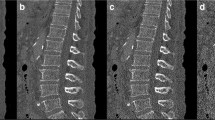Abstract:
The goal of this study was to assess whether a high-resolution CT measure of trabecular bone structure can enhance the discrimination between subjects with or without a vertebral fracture and having overall low hip or spine bone mineral density (BMD) by dual-energy X-ray absorptiometry (DXA). Sixty-one women with low BMD by DXA (T-score <–2.5 at hip or spine) were examined. Twenty women had sustained a vertebral fracture. Quantitative CT (QCT) BMD and high-resolution CT spinal scans were performed on a whole-body CT scanner. For the high-resolution images (0.31 mm pixel, 1.5 mm thick slice), trabecular bone was segmented from marrow using an adaptive threshold, region growth and skeletonization step. From the processed image we measured the apparent trabecular bone fraction (BV/TV), apparent trabecular thickness (I.Th) and apparent trabecular spacing (I.Sp). We also assessed the connectivity of the marrow space using region growing to derive a mean (HA) and maximum (HM) hole size. Despite the fact that the study population was preselected to have a low BMD by DXA, QCT BMD was highly associated with (p <0.005) with fracture status. All structural parameters were correlated (r ~ 0.64 to 0.79) with BMD with p <0.003 and showed significant differences between the fracture and non-fracture group. However, except for HA, this difference did not remain significant after adjustment for BMD. When BMD and then HA was entered into a paired linear regression model to predict fracture outcome, HA contributed with p= 0.03 and BMD with p= 0.86. ROC analysis was applied and showed that HA, BMD, I.Th and I.Sp discriminated the two groups with areas of 0.76, 0.75, 0.71 and 0.68, respectively. These findings suggest that an assessment of vertebral trabecular structure from high-resolution CT images is useful in discriminating subjects with vertebral fractures and potentially useful for predicting future fractures.
Similar content being viewed by others
Author information
Authors and Affiliations
Additional information
Received: 10 October 1997 / Accepted: 4 December 1997
Rights and permissions
About this article
Cite this article
Gordon, C., Lang, T., Augat, P. et al. Image-Based Assessment of Spinal Trabecular Bone Structure from High-Resolution CT Images. Osteoporos Int 8, 317–325 (1998). https://doi.org/10.1007/s001980050070
Issue Date:
DOI: https://doi.org/10.1007/s001980050070




